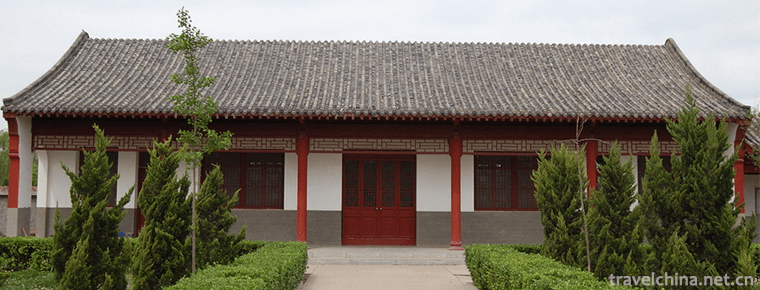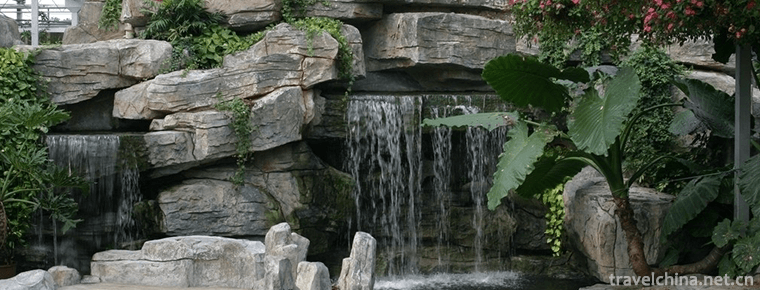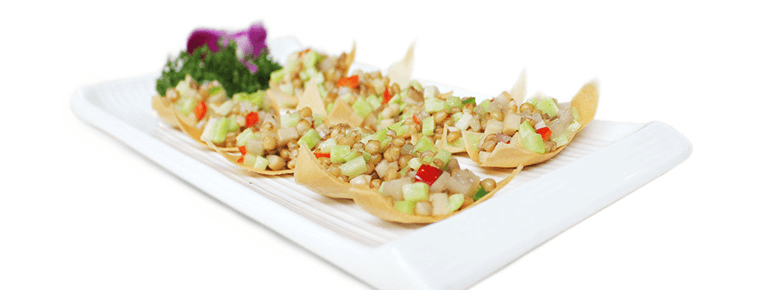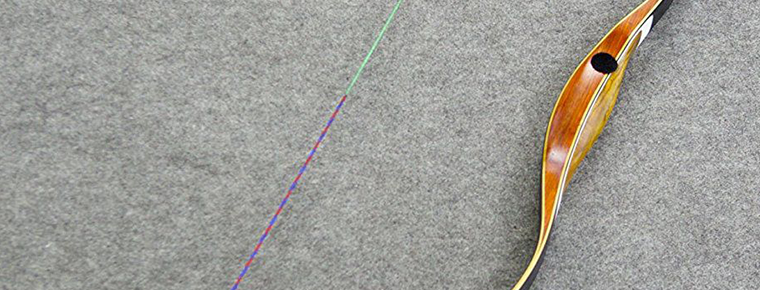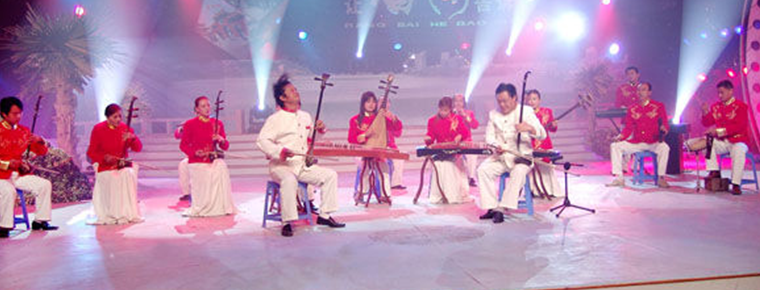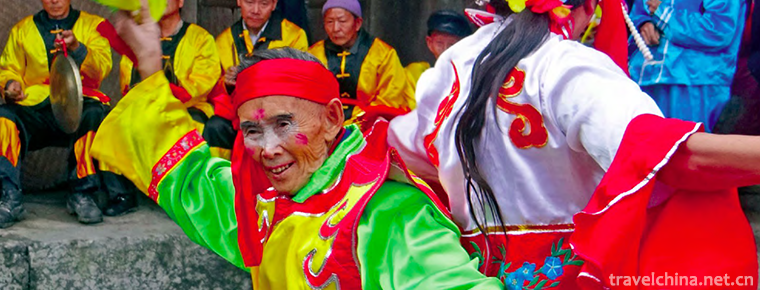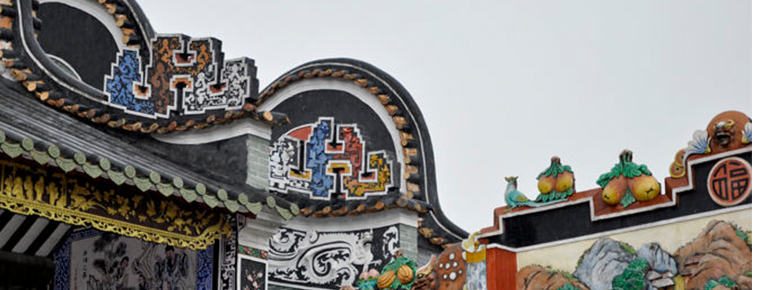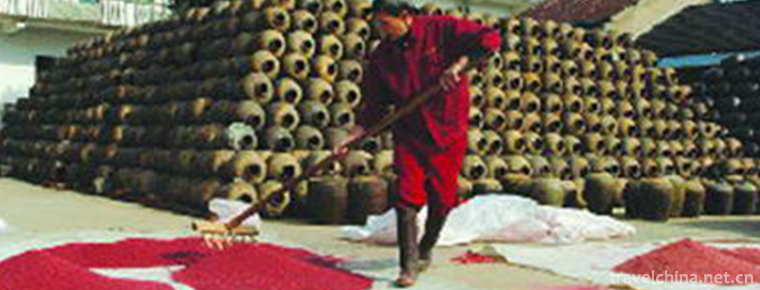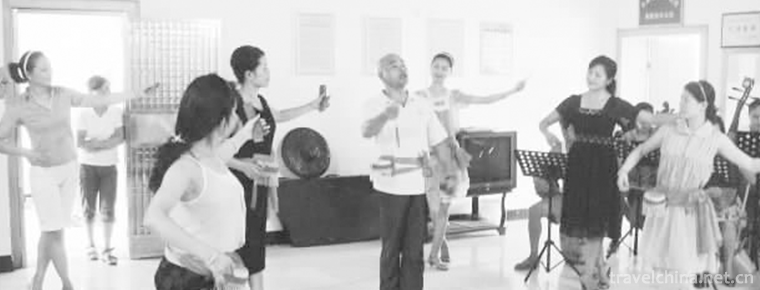Emei Chito
Emei Chito
"A Mei Qituo" is the original ecological dance name of a group of Yi people. It is translated as "Girl Marriage Dance" in Chinese and originated from Sanbao Yi Township in Qinglong County, Guizhou Province. Sanbao Yi Township is located in the southern part of Qinglong County, Guizhou Province. It has always belonged to the remote minority poverty-stricken mountainous areas in history. Therefore, because the natural environment is in a relatively closed state, its excellent traditional art forms are relatively intact. In 1956, "A Mei Qituo" performed for the central leadership in Huairen Hall after attending the first industrial and agricultural after-art exhibition in Guizhou Province and winning the prize. Since then, due to production, life, economic poverty and other factors, resulting in the disappearance of "A Mei Qi Tuo". After the Third Plenary Session of the Eleventh Central Committee of the Communist Party of China, under the condition of the gradual development of the local economy, "A Mei Qi Tuo" was gradually carried forward.
In 2014, it was listed in the national intangible cultural heritage protection list.
Excavation Brief
Sanbao Yi Township is located in the southern part of Qinglong County, Guizhou Province. It has always belonged to the remote minority poverty-stricken mountainous areas in history. Therefore, because the natural environment is in a relatively closed state, its excellent traditional art forms are relatively intact. "A Mei Qituo" has a long history. In 1956, "A Mei Qituo" performed for the central leadership in Huairen Hall after attending the first industrial and agricultural after-art exhibition in Guizhou Province and winning the prize. Since then, due to production, life, economic poverty and other factors, resulting in the disappearance of "A Mei Qi Tuo". The backward economic conditions have annihilated "A Mei Qi Tuo" for more than 20 years. After the Third Plenary Session of the Eleventh Central Committee of the Communist Party of China was held, the Party Committee and the government shifted the focus of their work to economic construction. Under the condition of the gradual development of the local economy, the work of rescuing the national folk cultural heritage was included in the agenda of the propaganda and cultural departments. In 1981, Qinglong County Cultural Museum dispatched mass cultural workers to Sanbao Township to study the Yi culture and art specimen in the process of rescuing "A Mei Qi Tuo". In the autumn of 1986, the office of Qinglong County Local Chronicle was collecting and sorting out the local cultural and artistic materials. Only Mao Taiyu and other people were known to have jumped "A Mei Qi Tuo", so it was rare that "A Mei (or translated rice) Qi Tuo" was intercepted into the local historical document "Qinglong County Chronicle" to make it inherited. The Southwest Guizhou Ethnic Opera Troupe also sent Zheng Gang and others to go deep into the Sanbao Collection Style and put the original ecological "A Mei Qi Tuo" on the stage, which was welcomed by the local audience and inspired the creators, and then carefully processed. In 1992, on the occasion of the 10th anniversary celebration of the founding of the Buyi and Miao Autonomous Prefecture in Southwest Guizhou, Qinglong County Cultural Bureau took "A Mei Qituo" out of the mountains to form a performing team. On May 1, Qinglong's "A Mei Qi Tuo" original ecological dance made its first appearance at Xingyi Stadium, where the state capital is located. In 1995, he participated in the Italian "World Folk Literature and Art Festival". With the deepening of poverty alleviation and development in rural areas and the rapid development of rural economy, "A Mei Qi Tuo" shows its artistic charm freely on the land of her hometown, and gradually develops and flourishes.
Cultural history
The folk culture and art forms of Sanbao Yi nationality mainly include folk songs, folktales and dances. Folk songs are widely expressed, with few stories or legends, and their dances are extremely rare. So far, only "A Mei Qituo" has been found. This is directly related to the ethnic group and its living environment. Tracing back to the ancestors of this ethnic group, it was originally a branch of the ancient Western Ethnic group, called "Xicuan Baiman" in history, and lived in the northwest of Yunnan (another branch is called "Dongcuan Wuman"). Historically, there have been many wars between tribes. Xipu Baiman was defeated. According to the agreement between tribes, the losers became slaves and the winners were masters. In the second year of Tang Dynasty (A.D. 751), Wu Man opposed Tang Dynasty and was known as "Yuyabu". He ruled most of the border areas of Yunnan, Guizhou and Sichuan provinces. It was not until the Yuan Dynasty to the eighth year of A.D. that Wu Man fell to the centralization of Yuan Dynasty. In the meantime, the appellation of tribal groups gradually evolved into "Baiyi" that is, the original Wuman (the distinction between Baiyi and Black Yi, which ended with the end of the Republic of China, and after the founding of the People's Republic of China, the state took the tripartite Yi as a collective name). Because Baiyi ancestors were unwilling to endure the slavery, oppression and exploitation of Yi and Han rulers, their families migrated, fled their homeland, trekked mountains and rivers into the Beipanjiang River Basin, lived in seclusion in the deep mountains, and depended on mountains and forests for their livelihoods, isolated from the world, forming a semi-closed or even closed pattern. Its production form is slash-and-burn cultivation and hunting, and its culture and art can only be inherited by means of words and deeds in this relatively closed environment. Indeed, from the overall reflection form of the national cultural language, the Yi nationality is a nation that enjoys the use of written language (Yi language). But in the history of this nation, the Yi language was completely mastered and strictly controlled by its rulers. The exploited poor, especially the slaves, could hardly even touch and use it. It can be inferred that the mystery of "A Mei Qi Tuo" without written (written language and graphics) records is not difficult to crack. The so-called word-and-deed teaching is the grandmother, mother-to-daughter, daughter-to-granddaughter, and only passed down from generation to generation in the maternal line. It tells the meaning and main points of its actions by word of mouth, and then teaches its hand-to-hand dance and foot-to-foot dance by hand, so as to make its movements standardized (to meet the requirements of the instructors), so as to maintain its historical and original artistic form.
Artistic connotation
"A Mei Qituo" belongs to the Yi marriage custom dance without music accompaniment. When the newly married girl was getting married, the female companions in Zhai Zhong and its neighboring villages came to see her off one after another.
On the occasion of departure from the bride, express the reluctant mood of the female companions, and warn the bride that after sitting at home, she should be diligent and thrifty in housekeeping, filial piety to her parents, husband and son-in-law, and respect her neighbours; wish the bride and her husband the whole family live in harmony and prosperity. "A Mei Qituo" is a dance gradually formed by the Yi people in the process of their long-term production and work, daily life and the development of their national history and culture. From the unique humanistic landscape of "A Mei Qi Tuo", we can still reflect the ancient historical and cultural information of the nation and its local cultural connotation. "A Mei Qituo" is a group dance of women. It is formed in an even number, either in a straight line or in a circle. Eight or twelve or sixteen people are divided into groups. The number of people increases or decreases by an even number, and they can dance hand in hand. The dance can be divided into twelve sections, namely, the umbrella step in Yi language (Chinese translated as "Goodbye and Marriage"), the non-step mother in West China (diligent and thrifty housekeeping), the hooks (sending sickles), the coaxing (transplanting seedlings), the festival between roots (happiness depends on labor), the lotus seedlings (stuffing), the machine block (cultivation), Ji. Tajimota (Happy Labor), its awakening (wish the bride a lifetime of happiness), the formation of the whole dance body language gene, all from production and life, and the hope for a better future. Its movements mainly depend on the movement changes of hip joint, knee joint and ankle joint to show the beauty of dance. Performers cooperate with each other tacitly, it can be said to achieve the realm of silk, so that its movements are neat, clean and neat, the sound of foot tapping, very crisp, to foot emotional, shocking, to the viewer's visual impact and artistic appeal, amazing. No wonder some people give "A Mei Qi Tuo" the reputation of "Oriental Tap Dance". Qinglong Yi's original ecological marriage dance "A Mei Qituo" handed out a business card to the world in the 2007 "Colorful Guizhou" dance contest. Now it has been declared as "the list of intangible cultural heritage protection in Guizhou Province", and then it has been declared into a higher-level "list of intangible cultural heritage protection". Nowadays, "A-Mei-Qi-Tuo" has entered Sanbao Yi School, which is a compulsory course on campus. It is not difficult to imagine that "A-Mei-Qi-Tuo" will be more brilliant in this folk art.
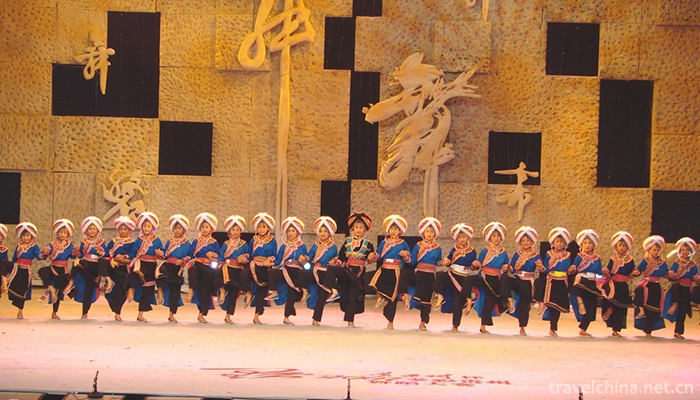
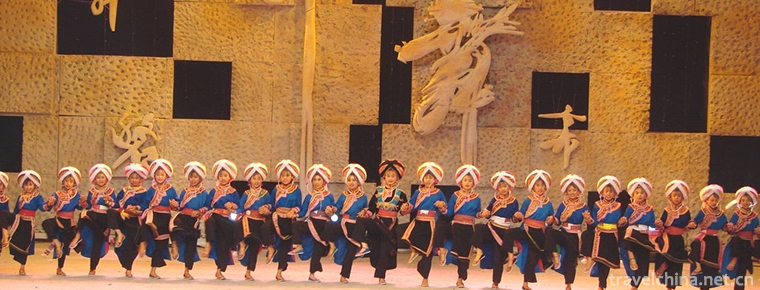
Emei Chito
-
Penglai Ocean Polar World
Penglai Ocean Polar World is located at the foot of Penglai Danya Mountain. It is adjacent to the famous Penglai Pavilion. It is invested by Penglai Haifeng Industrial Co., Ltd. for 460 million yuan
Views: 250 Time 2019-02-07 -
Yicheng Temple Scenic Spot of Sun Bin Tourist City
Sun Bin Tourist City is located in Jishan Town, 20 kilometers northeast of Juancheng County, Heze City, Shandong Province. Juancheng is the hometown of Sun Bin, a famous
Views: 97 Time 2019-02-13 -
Tengtou Ecological Tourism Area
Embedded between Fenghua and Xikou, Tengtou Eco-tourism Area is located in Xiaojiang Plain, close to Jiangba and Yongxi Highway. Located 6 kilometers north of Fenghua City
Views: 250 Time 2019-02-13 -
Sea cucumber with eight treasures
Babao sea cucumber is a traditional dish in Yichang City, Hubei Province. "Babao" means ham, hoof tendons, chicken, winter bamboo shoots, shrimp, mushrooms, lotus seeds and water chestnut; i
Views: 176 Time 2019-03-25 -
Slab headed qu
Nanyang Bantou music is a unique traditional string music. Music and the Central Plains drum tunes (major tunes) with a long history complement each other. They are preludes played in solo and ensembl
Views: 218 Time 2019-04-03 -
Traditional archery
The traditional bow is an ancient invention consisting of three parts: wood, horn and tendon. The manufacturing process is complex and the materials used are various, and the workmanship and material
Views: 170 Time 2019-04-19 -
Major tune
The major tune was originally called "drum tune". Varieties of Quyiqu. It was first prevalent in Kaifeng, Henan Province, and then spread to Luoyang, Nanyang and other places.
Views: 376 Time 2019-04-23 -
Gulin lantern
Gulin lanterns, centered on Gulin, are widely distributed in the middle reaches of Chishui River at the junction of Sichuan, Guizhou and Yunnan provinces.
Views: 346 Time 2019-05-01 -
Grey plastic
Gray plastic gray plastic, known as gray batch in ancient times, is the traditional architectural decoration technology in Lingnan area. The material is mainly lime.
Views: 370 Time 2019-05-04 -
Traditional Brewing Techniques of Brewing Wine
The traditional brewing technology of Jinhua liquor is the traditional handicraft technology of Jinhua City, Zhejiang Province. The typical representative and complete remains
Views: 154 Time 2019-06-07 -
Yongxin Drum
Yongxin Xiaogu is one of the traditional operas in Ji'an City, Jiangxi Province, which originated from Taoism. Legend has it that it was formed in Yongxin, Jiangxi Province during the reign of Qingdao
Views: 200 Time 2019-07-14 -
Cai Lun
Cai Lun(?-121 years ) Zhong Zhong, a member of Guiyang County in Eastern Han Dynasty. Emperor Ming of Han Yongping entered the palace in the end, Zhang and two years (AD 88). Cai Lun was promoted to t
Views: 320 Time 2019-09-06

